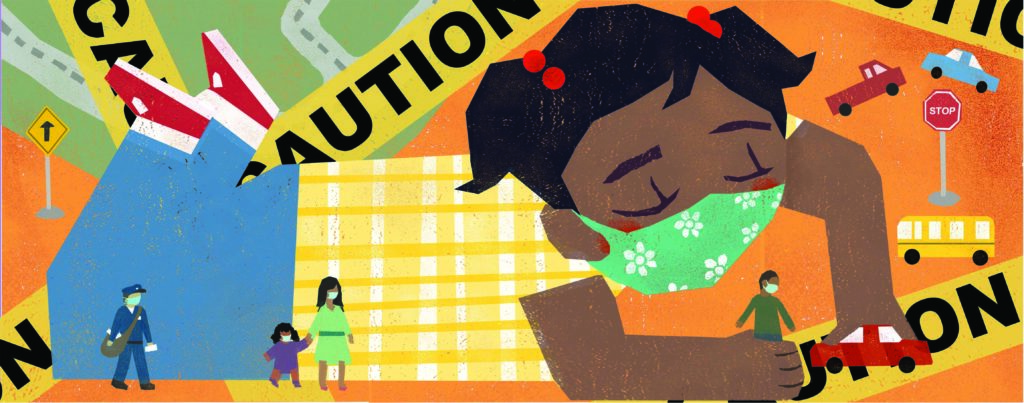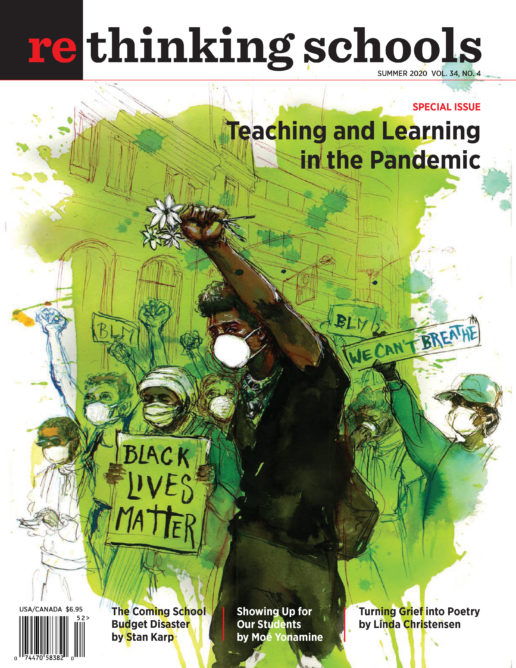Talking to Young Children About COVID-19
Illustrator: Simone Shin

COVID-19 descended upon Seattle, seeping in like a fog first in small ways, then eventually in signals we couldn’t ignore. Stores were empty, hours at our early childhood center were limited. A constant state of interruption became the norm. We kept reminding the kids to get up and wash their hands, cover coughs, and keep as much distance from one another as we could expect of 3-year-olds. They had to contend with a harsh spike in our requests for these actions, confused by our sudden intensity. “Why are my teachers so worried about germs?” they may have been wondering. When we finally got the announcement of school closures, I spoke to five kids at lunch (less than half the group) that had made it to school that day.
“Do you know why we’re asking you to wash your hands a lot more?”
“Because of the sickness!” A 3-year-old boy said to me, his eyes wide and expectant.
“Yes! What is the sickness?” I responded.
“I don’t know,” he said back to me, contemplating his sandwich.
I said, “Grown-ups feel very nervous right now. Some people are getting sick. Some people only get a little bit sick, and some people get very, very sick. We know we have to wash our hands to protect other people from germs, and we have to do that even more now.” The kids nodded. In all truthfulness, I think this was all I needed to say.
I’ve often talked with my colleagues about the best ways to inform children of current events that could affect their safety. We’ve been amazed by children’s capacity for following lockdown procedures; they responded quickly to move to an inner room in the building when an active shooter was in the neighborhood. We call lockdown drills “quiet drills” as a way to remind children to be “very sneaky and quiet until the grown-ups say it’s OK to talk.” We choose to leave out “bad people may want to hurt us” because we don’t need to scare children to get them to comply. We trust that children will ask for deeper reasons if they need them. There is a balance between sharing too much and sharing just enough. Adults must judge how much information is too much for a particular child. We need to remember that children are noticing the world around them through their specific young lens.
When talking to young children about big issues, we need to answer the questions children bring up as specifically and succinctly as possible. We want to help children stay informed without becoming overwhelmed. So when a child asked me during a lockdown drill, “Why do we have to go somewhere else?” I was able to answer truthfully and succinctly, “We’re practicing what to do if our classroom doesn’t feel safe. We go to a different safe place all together.”
As adults, we often have more problems with these topics than children do. We find it difficult to talk about illness and death with children because we have a complex history with them ourselves. We can carry trauma that makes it especially difficult to share essential information with children. In the case of COVID-19, perhaps we are worried for our own safety as adults, making it doubly hard to discuss with a child.
As adults, we often have more problems with these topics than children do. We find it difficult to talk about illness and death with children because we have a complex history with them ourselves. We can carry trauma that makes it especially difficult to share essential information with children. In the case of COVID-19, perhaps we are worried for our own safety as adults, making it doubly hard to discuss with a child.
The uncertainty of this time forces us to adapt and readapt, and really begs us to relearn one another.
Young children process information through play. Observing children as they play can help us understand the events and feelings they are trying to process. Children might make games of being sick and going to the hospital, or talking about closures. Phrases from the news or things discussed with other adults often show up in play. Children will sometimes act out scenarios of sickness or death. It can be valuable to talk a little, then play a little, allowing time to process, followed by inviting further thoughts or questions. Giving children the time, space, and our trust to hold and think about complex topics helps them to have confidence.
Children may be having more tantrums, making new demands, wanting to be near an adult all the time, or repeatedly asking the same questions. Digging into the source of children’s questions is helpful: Do they need reassurance? Are they looking for more information? Do they want an adult to restate facts? If I am frustrated by repeated questions, I sometimes reflect back to kids: “I remember we talked about why the park is closed yesterday. What do you remember about that?” I might add in my own feelings to help shape and give voice to children’s feelings: “I feel sad and disappointed when I see tape around the swings. I hope we can play here soon.” It is important for children to know that they can come to us in times of stress, and that they won’t just be shut down or shushed. Young children often experience big feelings that come out all at once; big feelings should be expected, and met with space, comfort, and warmth. Children need to be reminded that feelings are always OK, especially now.
As adults, we can model some of the ways that we’re managing this crisis. To help guide this, here are some ideas I’ve offered to parents and caregivers of students in my class:
• Talk to your children about ways to relax. A hug, a few deep breaths, a calming book, a bath, drawing, or singing could all be ways to re-center. Welcome new feelings, ask questions, set boundaries that highlight your own needs. Telling your child you could use some quiet time or a few minutes to lie down shows them that they can also advocate for these needs themselves.
• Try to limit conversations between adults about the news, or if you do talk about it, know that you are inviting little ears to join in and discuss with you. Consider reading news away from your child.
• Talk openly with children about factors that affect them: “We won’t be able to see your friends at school for a long time. What ideas do you have to stay in touch with them?” Make your best attempt to follow through on these plans, showing your child you respect their relationships.
• Nature never closes: Watch the sky and draw cloud shapes, take a quiet walk to listen for birds or other sounds in your neighborhood, find favorite colors outdoors, care for houseplants together, watch for animals and weather changes out your window.
• Try to find ways to destress and connect that allow children to remember people and places that are most important to them. Video calls or playdates with family and friends can help children to maintain connections.
• Tangibles are important to young children. The process of writing a letter or drawing a picture can help to bridge the physical divide of being apart. Delivering these by hand or sending them in the mail can be a way to feel physically connected.
• Routine is a great comfort to kids and promotes their executive function skills. Reminders of what day it is, what to expect, and inquiries into what they want to do, or what they might be doing at school help cue reminders of routines they’ve come to rely on. Especially if you are still working outside the home, allow space for yourself and build a consistent routine with your child upon returning home, considering your own stress and recovery day to day.
Our social opportunities may have dwindled, but there are wonderful opportunities to develop empathy. We can remind children about who is working to keep the grocery store stocked, the hospital running, the buses moving through the city. In this period of physical separation, a familiar smile on a computer screen, a drawing, or a letter can feel like a warm embrace.
Subscribe to Rethinking Schools magazine at rethinkingschools.org/subscribe.

